The S&P 500 has broken through an important Rush album resistance level…
Now it will be impossible for you to forget the level of the S&P 500. As your favorite Rush song dances around in your head, take a look at the big money chart below. U.S. Equities have been quietly caressing higher bases all year. And while the Bond and Currency markets have stolen the limelight due to their daily volatility, it is the S&P 500 which looks like it wants to make permanent waves higher. Note the collapse in the 20 day Bollinger® Band width, which should act as a distant early warning that the market is having a countdown to a big move. So hold your fire, power down the windows on your red barchetta and roll the bones because the vital signs are pointing to an end to this 4 month vapor trail of resistance. (For the analog kids out there, I included 13 references to our favorite Canadian import.)
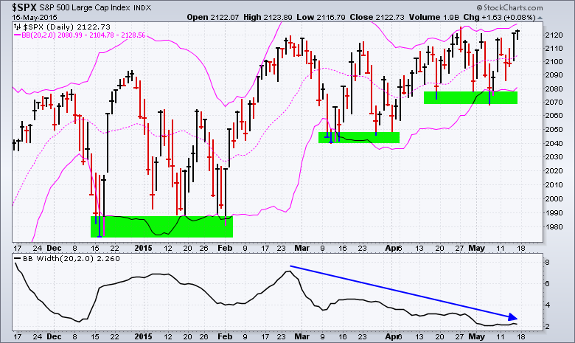
Bulls will note the significant M&A flow last week for another reason to justify a leg higher…
This week saw another batch of big movers on M&A headlines. (NYSE:PLL) +24.3% agreed to be acquired by (NYSE:DHR) +2.9% in a deal with an EV of $13.8B. DHR also announced that it would subsequently split into two separately traded public companies. The Street seemed positive on the strategic rationale, though valuation was cited as a concern. (NYSE:VZ) (0.7%) announced that it would acquire AOL (NYSE:AOL) +16.6% for $4.4B in a deal that generated a fairly lukewarm reaction from analysts. OI +16.6% was a standout on the favorable accretion takeaways surrounding its deal to acquire Vitro, Mexico’s largest glass maker, for ~$2.15B. In the energy sector, (NYSE:WMB) +5.6% agreed to purchase affiliate (NYSE:WPZ) +20.5% in an all-stock deal valued at $13.8B. (NYSE:NBL) (8.6%) said it would purchase (NASDAQ:ROSE) +25.1% in a deal with an EV of $3.9B. The semi space remained in focus as (NASDAQ:CY) +1.5% offered to acquire (NASDAQ:ISSI) +7.4% for $19.75 a share, slightly better than the $19.25 a share privatization deal the company agreed to back in March
Don’t forget that your U.S. capitalization weights are highly dependent upon your view of the US dollar.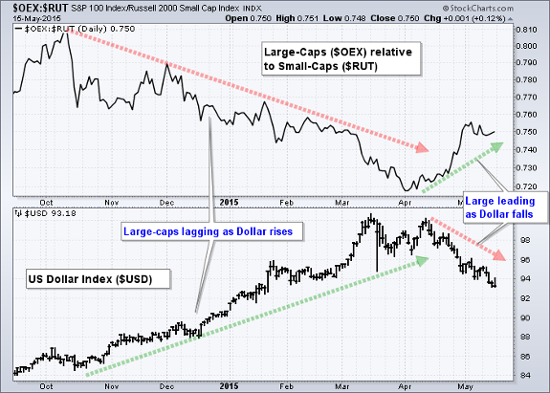
The falling Dollar is boosting large-caps and they are outperforming small-caps. This makes sense because large-caps are typically multinational companies that derive a good portion of their revenue abroad. The Financial Times estimates that companies in the S&P 500 generate around 40% of their revenues abroad. These foreign earnings must be converted to Dollars and a strong Dollar translates into lower earnings. A weaker Dollar, on the other hand, helps the bottom line for companies that generate revenues abroad. Chartists can see this relationship in action by comparing large-cap performance against the dollar
A great chart here by BofA Merrill Lynch. Note the windup in volatility in the Debt and Currency markets since 2012; just unreal how calm stocks have been over the same time frame. Janet and the Fed have one heck of a job ahead of them trying to keep Equities calm as they dial up rates…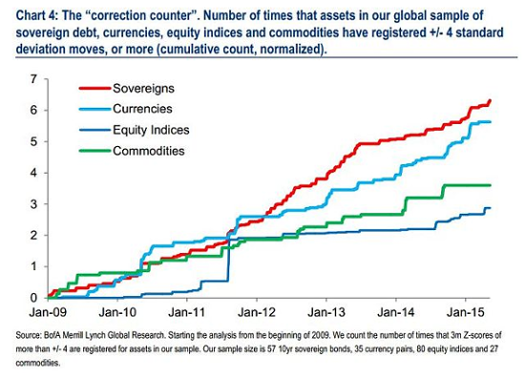
If you are looking for a chart to temper your equity enthusiasm, here it is. Corporate Bond spreads are widening even as Treasuries get their block knocked off…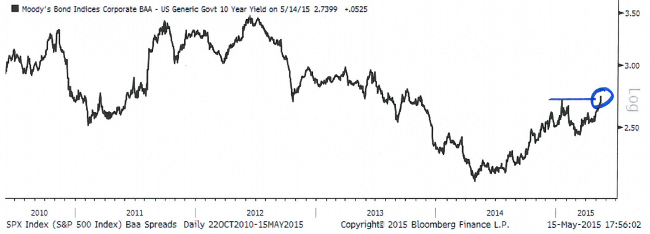
Lots of ‘Sell in May’ work running around; hopefully this table from the team at Leuthold might help you pick where to be. Small Caps and High Beta have the most difficult time during the summers. Once again, always a great time to hit the beach if you are a Small Cap growth manager…
I am not a big fan of Sentiment surveys, but do find it interesting when Bullish sentiment hits lows as the Market makes new highs. Maybe some extra fuel for more new highs…
Just because one might be looking down the road at diapers, doesn’t mean they need to move into bonds…
“Some wealth manager persuades Mr. Jones, a Baby Boomer, to sell Apple (NASDAQ:AAPL) stock to buy something safer, because he’ll soon need diapers,” continued the same CIO. “So to help out, Apple’s CFO issues 5yr bonds, sells them to Mr. Jones and uses the proceeds to buy back Apple stock.” Apple’s earning yield is 7%, 5yr Apple bonds yield 1.7%. “I have no love for Apple, I’m focused on the structure of the market, and one of these guys is wrong – Apple’s CFO or Mr. Jones – and I bet it’s Mr. Jones.”
Shareholder yields of stocks are also significantly higher than bonds. And as earnings grow, so will the yields…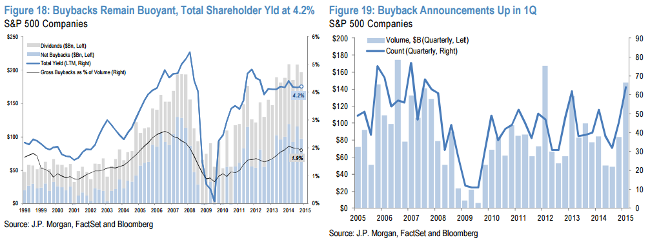
For the week, most XL sectors finished higher with Staples leading due to the weakness in the U.S. Dollar…
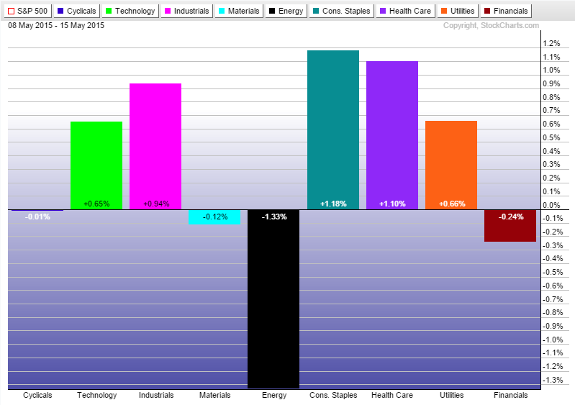
More broadly, International Equity ETFs led also due to the U.S. Dollar weakness combined with foreign Central Bank QE programs…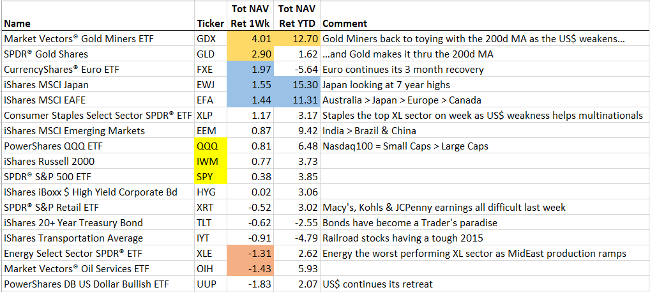
Lots of talk about the Transports recently; Energy, Coal and West Coast Port shutdowns have hurt Railroad earnings this year. But strip out recent Transportation stock weakness and Industrial stocks are actually performing solidly in May. No doubt there are buyers digging in the dirt looking for names to own if the U.S. Dollar continues to fall while Europe slowly improves…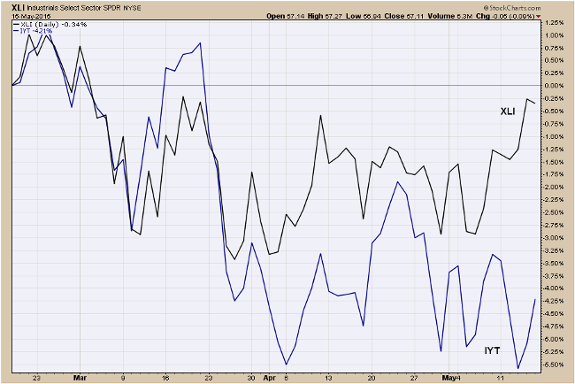
In the Energy space, while the U.S. Rig count continues to fall, the rate of that acceleration has slowed significantly…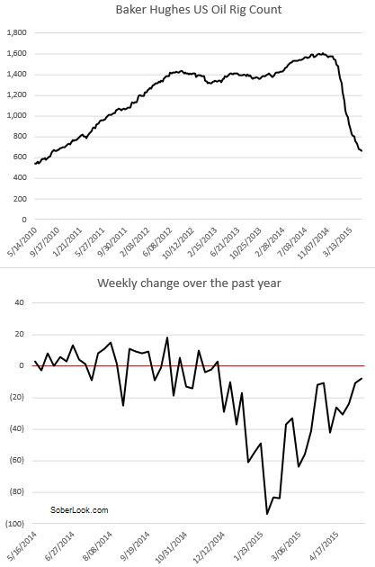
Goldman Sachs (NYSE:GS) made a big call over the weekend that most new Energy projects will be money losers as long-term oil prices fall into the $50s…
Most new oil and gas projects are set to be rendered uneconomical, according to equity analysts at Goldman Sachs, which predicts that the price of Brent crude will fall to $55 a barrel by 2020 from an earlier forecast of $70 a barrel.
Behind the numbers are three supply drivers:
1- Efficiency gains – these can lower break even costs for shale oil and push down oil prices, as shale “will be the marginal source of supply.”
2- OPEC production – the cartel has shifted its strategy from price maximization to market share, resulting in a jump in production. In Saudi Arabia, OPEC’s defacto leader, the number of rigs drilling for oil are up 35 per cent year over year and production stands in excess of 10m b/d. While Goldman Sachs cites Iraq as another source of increasing output, Iran too could be on the cards, reports Anjli Raval, oil and gas correspondent.
3- New projects with a lower break-even price – Santos in Brazil, Kurdistan, Kenya and the shale development in Vaca Muerta in Argentina would further add to production.
Meanwhile, the Energy ETF has hit its head hard on the 200 day moving average…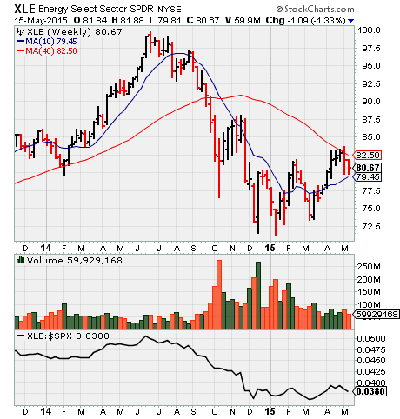
Lower energy prices were supposed to give U.S. retailers a boost in 2015. None of them saw it last week. Here is Macy’s explanation…
“Delayed merchandise shipments from the West Coast port slowdown and severe winter weather early in the quarter restrained business levels. Moreover, sales were negatively affected by lower levels of spending by international tourists visiting major U.S. cities with flagship Macy’s and Bloomingdale’s stores, including New York City, Chicago, Las Vegas and San Francisco.”
(Macy’s Conference Call)
Maybe the big apparel and home retailers will never see the low energy price benefit if Millennials don’t want to buy stuff, but instead experiences (and of course the iPhone 7)…
Retailers like Macy's (NYSE:M), JC Penney (NYSE:JCP), and Kohl's (NYSE:KSS)’s have all reported mediocre results this week. The companies have blamed a variety of temporary factors — such as delayed inventory shipments, bad weather in February, and fewer international tourists — for the slowdown in business. But Americans are increasingly spending less on clothes and home furnishings, a trend that could hurt the companies’ businesses for years to come.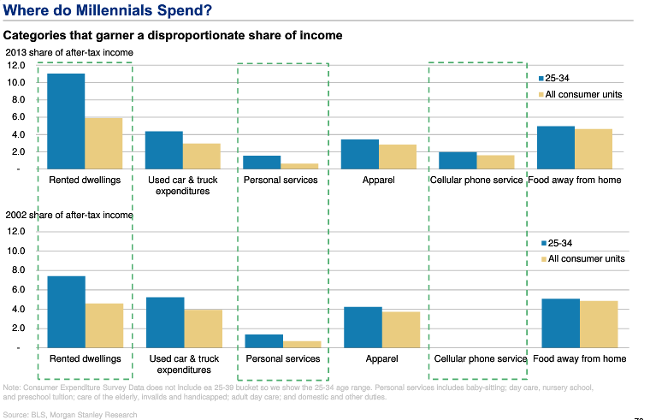
One thing we do know is that the Millennials, like the rest of us, are buying more goods online…
Although frigid weather kept many Americans away from malls and stores last quarter, it didn’t stop them from shopping on their laptops and smartphones. Sales on e-commerce websites increased 3.5 percent in the first three months of the year from the previous quarter, reaching a record $80 billion worth of purchases, according to seasonally-adjusted figures released by the Commerce Department on Friday. Meanwhile, total retail sales declined 1.5 percent, the first quarterly drop in almost three years. On a year-over-year basis, online purchases soared a whopping 14.5 percent, compared with a 1.6 percent increase for total sales
Looking for limit up Retail Sales? Look no further…
“Art likes to move around the world, but the scale is so much bigger now,” said Ed Dolman, chairman and chief executive of boutique auctioneer Phillips. “We’re talking an incredible orgy of spending, and it feels like a total transformation.” During the past two weeks, Sotheby’s and Christie’s have sold roughly $2.5 billion worth of art combined, up 25% from similar sales held last May and up 74% from auctions held during the market’s last peak in 2007. The stars this time around included an Alberto Giacometti sculpture, “Pointing Man” that sold for $141.3 million and reset the record price for a sculpture at auction. Picasso’s “Women of Algiers (Version O),” which sold for $179.4 million, set a new painting record as well
We would all have more money in our pockets if the U.S. were to end the Ethanol subsidies…
Congress doesn’t agree on much lately—but ending a failed policy that stymies small businesses, hurts the environment and increases food prices should be a bipartisan priority. Since the RFS was implemented in 2005, costs of vital food commodities, including corn, grains and oil seeds, poultry, meat, eggs and dairy, have risen dramatically. Here’s one major reason: The federal government’s corn-ethanol mandate requires that a percentage of the nation’s corn crop be blended into gasoline each year as ethanol. Every year the percentage required increases, diverting more of the nation’s corn supply into ethanol fuel. This harms the broader U.S. economy…
Between 1973 and 2007, corn prices averaged $2.39 a bushel, according to the U.S. Agriculture Department. The average price of corn jumped more than 110% between 2008 and 2014, to $5.04 a bushel. Even though corn prices have recently declined thanks to fabulous weather that produced two consecutive bumper crops, prices are still more than 59% higher than the historical average. Prices could surge even higher if the U.S. experiences anything less than ideal weather
David Kotok wrote this about Ethanol last month and I couldn’t stop thinking about it. Hopefully a Presidential candidate with an economics, finance or basic math class will advance to the next round so we won’t have to talk about corn based ethanol ever again…
If every sort of ethanol subsidy were repealed and there were zero subsidies in any form, would ethanol exist? It appears that the answer is no.
This is not the first time my car has been filled with non-ethanol fuel. It will not be the last time, either. I’m not opting for non-ethanol fuel to protest a lousy policy, although that might be an acceptable motivation. I’m electing to use non-ethanol fuel because it is better for my automobile.
I believe that ethanol is one of the sickest political diseases fostered by the United States, with impacts throughout the world. Our federal budget statistics show that billions of dollars have been expended to subsidize ethanol. Our politicians campaign early in Iowa out of fear for the Iowa corn farmer. Those scurrilous politicians will do whatever they can to placate farmers who are looking for preservation of ethanol policy so they can enjoy a subsidy paid for by the rest of us.
Speaking of bad decisions, could someone in a State government office decide soon that it is wrong to take from the less intelligent and instead hand every man, woman & child $230 per year?
This floored me: Americans in the 43 states where lotteries are legal spent $70 billion on lotto games in 2014. Seventy billion? I thought. No, that’s impossible. That’s more than $230 for every man, woman, and child in those states—or $300 for each adult. But it’s true: According to the North American Association of State and Provincial Lotteries, lotteries took in $70.1 billion in sales in the 2014 fiscal year. That’s more than Americans in all 50 states spent on sports tickets, books, video games, movie tickets, and recorded music sales.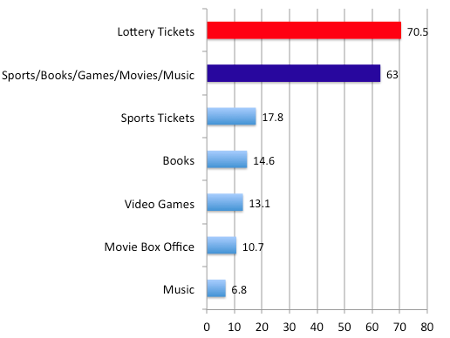
Finally, if you have clients in Illinois, it is probably time to start working through financial scenarios where all tax rates rise substantially. For residents of Chicago, start with a 50% increase to property, sales and income taxes. For residents of Illinois, do the same with a 25% increase in rates. Now that the State Supreme Court moved to stop pension cuts, the city and state have no other option than to raise rates substantially because they will no longer be able to borrow money at affordable rates. And as individuals and companies leave the state of Illinois to avoid higher taxation, there will be fewer revenues generated which will mean even higher tax rates will be needed. This is the beginning of the end for a great city and state. So if you have clients there, start running scenarios on what it will cost to live in Illinois. With property tax rates about to take flight, you don’t want your clients to be the last one on their block to list their house for sale…
These cuts degrade life in the city. That’s going to grow worse, as everything gets tossed over the side in order to keep ballooning pensions from capsizing the ship. At some point Chicago will hollow out and become an enormous pension plan that also puts out fires.
There is no facile solution, just a series of bad choices. A clear-cut sacrifice, like the Chicago Newspaper Guild made, isn’t even possible. Retirees can’t vote to cut their pensions to save the city and wouldn’t if they could. Taxes could be raised, though the common wisdom is that jacking up property taxes or increasing taxes on corporations would cause Chicago residents and companies to flee faster than they already are, leaving those who remain clawing at an ever smaller pie.
I believe this is referred to as the “death spiral.
The information presented here is for informational purposes only, and this document is not to be construed as an offer to sell, or the solicitation of an offer to buy, securities. Some investments are not suitable for all investors, and there can be no assurance that any investment strategy will be successful. The hyperlinks included in this message provide direct access to other Internet resources, including Web sites. While we believe this information to be from reliable sources, 361 Capital is not responsible for the accuracy or content of information contained in these sites. Although we make every effort to ensure these links are accurate, up to date and relevant, we cannot take responsibility for pages maintained by external providers. The views expressed by these external providers on their own Web pages or on external sites they link to are not necessarily those of 361 Capital.
